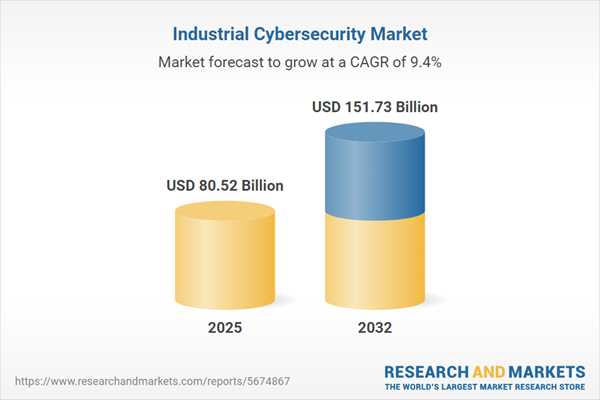Speak directly to the analyst to clarify any post sales queries you may have.
As industrial digitalization accelerates, the industrial cybersecurity market faces complex risks and new opportunities for senior decision-makers safeguarding operational continuity. Dynamic threat environments, evolving compliance standards, and technological innovation now demand a robust, adaptive strategy for industrial sectors.
Market Snapshot: Industrial Cybersecurity Market Overview
The industrial cybersecurity market expanded from USD 73.85 billion in 2024 to USD 80.52 billion in 2025, progressing at a 9.41% CAGR to reach USD 151.73 billion by 2032. This transformation reflects increased convergence of IT and operational technology (OT), rising regulatory focus, and an evolving threat landscape impacting global industrial stakeholders. Organizations across manufacturing, energy, and critical infrastructure sectors are strengthening investment in predictive defense, continuous monitoring, and integrated threat response platforms to address mounting risk and ensure compliance.
Scope & Segmentation
This report delivers a granular analysis covering all major security segments, emerging technologies, and regional markets shaping the industrial cybersecurity landscape:
- Security Type: Application Security, Endpoint Security, Network Security, Operational Security
- Offerings: Hardware Solutions (Encryption Storage Devices, Hardware Security Modules, Networking Devices); Services (Managed Services, Professional Services); Software Solutions (Endpoint Security Solutions, Intrusion Detection Systems, Risk & Compliance Management Software, Unified Threat Management)
- Deployment Mode: Cloud-Based, On-Premise
- Industry: Construction, Energy & Utilities (Oil & Gas Operations, Power Generation Plants), Healthcare & Life Science, Manufacturing (Automotive, Electronic Components, Machine Manufacturing), Telecommunication
- Regions: Americas (North America: United States, Canada, Mexico; Latin America: Brazil, Argentina, Chile, Colombia, Peru), Europe, Middle East & Africa (Europe: United Kingdom, Germany, France, Russia, Italy, Spain, Netherlands, Sweden, Poland, Switzerland; Middle East: United Arab Emirates, Saudi Arabia, Qatar, Turkey, Israel; Africa: South Africa, Nigeria, Egypt, Kenya), Asia-Pacific (China, India, Japan, Australia, South Korea, Indonesia, Thailand, Malaysia, Singapore, Taiwan)
- Key Companies: ABB Ltd., Alstom S.A., Amazon Web Services, Inc., Armis Inc., Baker Hughes Company, Bechtel Corporation, Broadcom Inc., Cisco Systems, Inc., Claroty Ltd., Continental AG, CrowdStrike Inc., CyberArk Software Ltd., Dell Technologies Inc., Fortinet, Inc., Honeywell International Inc., Industrial Defender, International Business Machines Corporation, McAfee Corp., Microsoft Corporation, Oracle Corporation, Palo Alto Networks, Inc., Rockwell Automation, Inc., Schneider Electric SE, ScienceSoft USA Corporation, Siemens AG, Vumetric Inc. by TELUS Corporation
Key Takeaways for Senior Decision-Makers
- Digital transformation is merging operational and information technology, expanding attack surfaces and demanding cross-functional security governance.
- AI, machine learning, and digital twin technologies are becoming critical to automate threat detection and enable predictive, risk-based responses across industrial assets.
- The adoption of zero trust architectures and edge computing is minimizing vulnerabilities and enhancing resilience for mission-critical systems.
- Cloud-native security solutions and managed services are making enterprise-grade protections accessible to organizations of all sizes, facilitating rapid deployment without in-house expertise.
- Collaboration between IT and OT teams is accelerating, with organizational culture shifting towards proactive, unified threat management and cross-training initiatives.
- Industry-specific requirements drive investment in scalable, compliant solutions that balance operational uptime, safety, and regulatory mandates across key verticals.
Impact of United States Tariffs on Supply Chains and Cost Structures
Starting in January 2025, new tariffs on industrial hardware components have resulted in increased procurement costs and complex supply chain adjustments for cybersecurity solutions. Key components like hardware security modules and encryption devices are particularly affected. In response, organizations are diversifying their supplier base, reevaluating contracts, and building buffer stocks to manage disruptions. Tariff-driven price changes have also led to creative service agreements, with managed service providers absorbing some costs while revising contract models and exploring domestic alternatives. Strategic partnerships, early engagement with manufacturers, and hybrid sourcing frameworks are recommended to navigate fluctuating trade policies and safeguard ongoing security initiatives.
Research Methodology & Data Sources
This executive summary is grounded in primary interviews with cybersecurity leaders and industry analysts, supplemented by comprehensive secondary research from technical journals, regulatory documents, and publicly available company disclosures. Analytical frameworks focused on thematic coding, cross-validation, and iterative expert review ensure the accuracy, credibility, and relevance of all insights presented.
Why This Report Matters
- Gain clarity on actionable priorities and next-generation defenses for industrial organizations confronting evolving cyber threats.
- Understand regional, regulatory, and technological nuances to support informed investments and sustainable security roadmaps.
- Leverage segment-specific insights to benchmark current programs and engage confidently with cross-functional teams and external partners.
Conclusion
Equipped with critical market data, technology trends, and strategic recommendations, this report supports senior leaders in designing resilient, adaptive cybersecurity strategies for industrial environments. The insights enable robust risk management and position organizations for growth amid an ever-changing threat landscape.
Additional Product Information:
- Purchase of this report includes 1 year online access with quarterly updates.
- This report can be updated on request. Please contact our Customer Experience team using the Ask a Question widget on our website.
Table of Contents
3. Executive Summary
4. Market Overview
7. Cumulative Impact of Artificial Intelligence 2025
Companies Mentioned
The companies profiled in this Industrial Cybersecurity market report include:- ABB Ltd.
- Alstom S.A.
- Amazon Web Services, Inc.
- Armis Inc.
- Baker Hughes Company
- Bechtel Corporation
- Broadcom Inc.
- Cisco Systems, Inc.
- Claroty Ltd.
- Continental AG
- CrowdStrike Inc.
- CyberArk Software Ltd.
- Dell Technologies Inc.
- Fortinet, Inc.
- Honeywell International Inc.
- Industrial Defender
- International Business Machines Corporation
- McAfee Corp.
- Microsoft Corporation
- Oracle Corporation
- Palo Alto Networks, Inc.
- Rockwell Automation, Inc.
- Schneider Electric SE
- ScienceSoft USA Corporation
- Siemens AG
- Vumetric Inc. by TELUS Corporation
Table Information
| Report Attribute | Details |
|---|---|
| No. of Pages | 194 |
| Published | November 2025 |
| Forecast Period | 2025 - 2032 |
| Estimated Market Value ( USD | $ 80.52 Billion |
| Forecasted Market Value ( USD | $ 151.73 Billion |
| Compound Annual Growth Rate | 9.4% |
| Regions Covered | Global |
| No. of Companies Mentioned | 27 |









